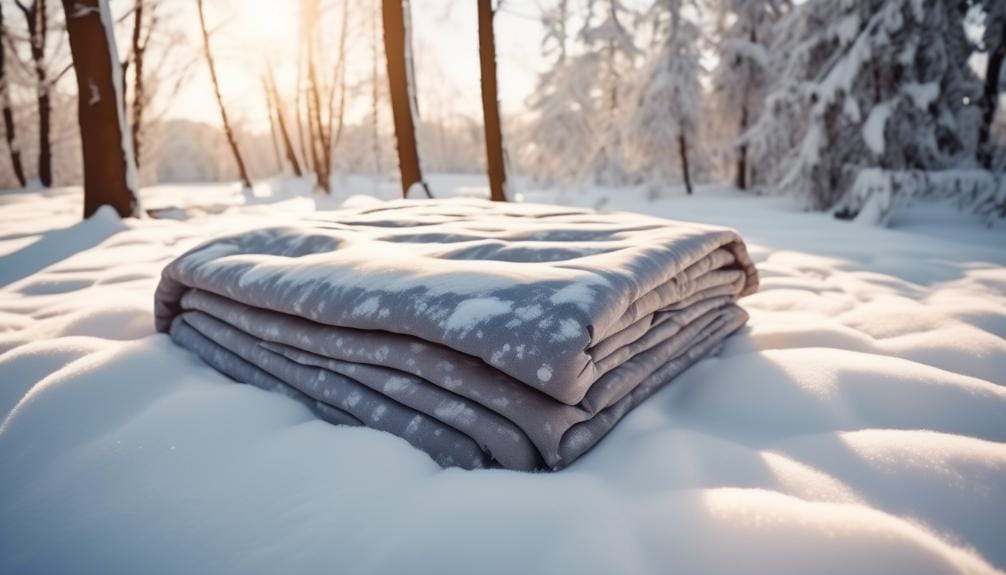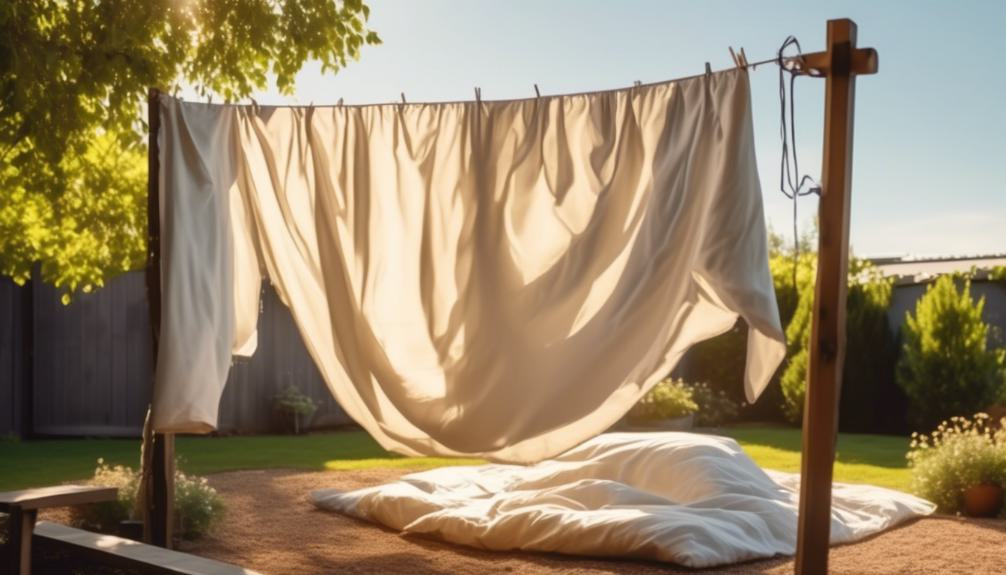How to Dry Duvet Cover Without Dryer: Can Sunlight Be The Answer?
You may think that drying a duvet cover without a dryer is a daunting task, but with the right techniques, it can be a simple and effective process.
The question you might be asking yourself is, can sunlight really be the answer? Let’s explore how harnessing the power of the sun can be a practical and eco-friendly solution for drying your duvet cover, offering an alternative to traditional drying methods.
Whether you’re seeking to minimize your environmental impact or simply don’t have access to a dryer, discovering the benefits of sun-drying might just change the way you approach caring for your bedding.
Key Takeaways
- Air drying methods, such as line-drying and using an airer or drying rack, can effectively dry duvet covers without a dryer.
- Harnessing heat sources like a radiator or space heater can expedite the drying process.
- Sunlight can be a cost-effective and eco-friendly alternative for drying duvet covers, as it naturally freshens and deodorizes the fabric.
- Drying duvet covers in winter can be achieved by utilizing external heat sources, such as a radiator or space heater, and increasing air circulation with fans.
Air-Drying Your Duvet Cover
When air-drying your duvet cover, consider utilizing various methods such as line-drying, using an airer or drying rack, and harnessing heat sources like a radiator or space heater to expedite the drying process.
Line-drying your duvet cover is an effective method, as it allows for proper air circulation and sunlight exposure, which can help eliminate any lingering odors. Additionally, using an airer or drying rack allows the duvet cover to be spread out evenly, promoting quicker and more even drying. Harnessing heat sources like a radiator or space heater can expedite the process, particularly in colder or humid climates.
Proper air drying of duvet covers is crucial for maintaining their quality and ensuring a restful sleep environment. By allowing the cover to fully dry, you can prevent mold and bacteria growth, preserving the loft and insulation properties of the duvet. This not only extends its lifespan but also contributes to improved sleep quality and comfort.
Furthermore, sunning pillows and bedding can refresh and deodorize the fabric, remove odors, dust mites, and allergens, and brighten the material, making it a worthwhile practice to incorporate into your drying routine.
Using Heat to Dry Your Duvet Cover
When it comes to drying your duvet cover using heat, there are several effective methods to consider.
Utilizing external heat sources such as a radiator or space heater during the winter can expedite the drying process.
Hanging your duvet near a heat source on a clothing rack or using a portable drying rack with built-in heating elements can also help speed up the drying time.
Sunlight as Drying Alternative
Harness the natural power of sunlight to efficiently dry your duvet cover and impart a fresh, clean scent without relying on energy-consuming appliances. Placing your duvet cover in a warm, well-lit area with good air circulation under direct sunlight can help expedite the drying process. Sunlight not only accelerates drying but also naturally freshens and deodorizes the duvet cover, providing a cost-effective and eco-friendly option. Regular sunning of bedding, including duvet covers, can help maintain cleanliness, freshness, and extend their lifespan. Consider utilizing drying racks in a sunny spot or hanging the duvet cover on a clothesline to maximize exposure to sunlight. Take advantage of this natural, energy-efficient method to keep your duvet covers clean and fresh.
| Pros | Cons |
|---|---|
| Natural, energy-efficient method | Relies on weather conditions |
| Cost-effective and eco-friendly | Requires space for drying |
| Imparts a fresh, clean scent | Potential fading of colored covers |
| Helps maintain cleanliness and freshness | Limited effectiveness in winter |
| Extends the lifespan of duvet covers |
Benefits of Air Drying
To effectively air dry your duvet cover using heat, consider utilizing a warm and well-ventilated space to maintain the loft and insulation properties of the duvet.
The benefits of air drying with heat are numerous. Heat from air drying helps preserve the loft and insulation of your duvet, ensuring it continues to provide warmth and comfort. Using sources of heat, such as a radiator or space heater, can be particularly effective in winter or on a cloudy day.
It also speeds up the drying process, especially in a warm and well-ventilated room. Moreover, the use of heat during air drying helps prevent the growth of mold, mildew, and bacteria on your duvet, ensuring it stays fresh and hygienic.
Drying a Duvet Cover in the Winter

In the winter, you can effectively dry a duvet cover by utilizing external heat sources such as a radiator or space heater in a warm room with good air circulation. When the weather is cold and sunlight is scarce, these alternative methods can help you ensure your duvet cover is thoroughly dried and ready to use without the need for a dryer.
Here are some tips for drying a duvet cover in the winter months:
- Utilize External Heat Sources: Place the duvet cover near a radiator or use a space heater in a well-ventilated room to provide gentle warmth for drying without exposing it to harsh elements.
- Consider Hairdryer for Spot Drying: If certain areas of the duvet cover are taking longer to dry, consider using a hairdryer on a low heat setting to accelerate the drying process.
- Use Fans for Air Circulation: To speed up drying, use a fan to increase air movement around the duvet cover, helping to reduce moisture and dry it more efficiently in the winter.
Harnessing Sunlight for Drying
Placing your duvet cover in direct sunlight can expedite the drying process while naturally freshening and sanitizing the fabric. Sunlight’s natural warmth and UV rays help to evaporate moisture, making it an effective and eco-friendly alternative to using a dryer.
The direct exposure to sunlight can also aid in eliminating odors, brightening the fabric, and reducing allergens such as dust mites, due to its natural sanitizing properties.
Harnessing sunlight for drying not only saves energy but also helps to prolong the life of your duvet cover by reducing wear and tear from high heat in dryers. To make the most of sunlight, ensure that the duvet cover is spread out evenly to allow maximum exposure. It’s important to periodically rotate the cover to ensure even drying.
However, be cautious of prolonged exposure to direct sunlight, as it may cause colors to fade over time. By utilizing sunlight, you can effectively dry your duvet cover while benefiting from the natural freshness and sanitization that it provides.
Quick Drying Methods for Duvet Covers

When looking for quick drying methods for your duvet cover, harnessing sunlight can be a highly effective option.
Indoor air drying techniques such as using a clothing rack in a semi-enclosed space and utilizing a space heater can also speed up the drying process.
These methods can ensure that your duvet cover is ready to use in a shorter amount of time, allowing you to maintain its quality and enjoy a comfortable night’s sleep.
Sunlight as Drying Method
Harness the natural power of sunlight to efficiently dry your duvet covers, ensuring quick and thorough results. When utilizing sunlight as a drying method for your duvet cover, keep the following tips in mind:
- Optimal Placement: Hang the duvet cover outside in direct sunlight, ensuring that it’s exposed to as much sunlight as possible for faster drying.
- Regularly Flip and Air: Periodically flip the duvet cover to ensure even drying, and allow it to benefit from the sun’s natural airflow.
- Sunlight Benefits: Sunlight not only speeds up the drying process but also helps eliminate dampness, odors, bacteria, dust mites, and allergens present in the duvet cover, while maintaining its loft and insulation properties.
Indoor Air Drying Techniques
To quickly dry your duvet covers indoors, utilize various methods such as:
- Line-drying: Hang the duvet cover on a line indoors to facilitate air drying.
- Using an airer: Utilize a drying rack or airer to allow for efficient circulation of air around the duvet cover.
- Draping over a door: Drape the duvet cover over a door to take advantage of the air circulation within your home.
- Utilizing a curtain pole: Use a curtain pole to hang the duvet cover and promote air drying.
In colder months, consider using heat sources like a radiator or space heater to expedite the drying process. Additionally, using a fan to increase air movement can help speed up the drying time.
Sunning Pillows and Bedding
You can naturally refresh and deodorize pillows and bedding by sunning them, which removes odors, dust mites, mildew, allergens, and even lightens stains.
To sun pillows, remove the pillowcases and place them on a clothes-drying rack or peg them to a clothesline in a sunny spot, ensuring proper airflow through the pillows. Sunning pillows not only refreshes and sanitizes them without harsh chemicals but also benefits natural fiber pillows like those filled with organic wool or down.
When sunning natural bedding, choose a hot, sunny day and ensure proper airflow, leaving the bedding outside for a full day or at least 4 hours, flipping and fluffing thicker bedding like wool toppers or comforters halfway through.
Enjoy the benefits of sunned bedding by bringing it indoors after sunning, letting it rest for an hour to dissipate outdoor humidity, and making up the bed with the freshly sunned bedding or storing it away for future use.
Washing and Drying Down Comforters

When it comes to washing and drying down comforters, it’s essential to follow specific guidelines to maintain their loft, insulation, and overall quality.
After washing your down comforter, ensure proper drying to prevent clumping and maintain its fluffiness. Air drying is the best method for down comforters, as it prevents damage to the delicate down clusters. Find a well-ventilated area with good air flow, such as an outdoor clothesline or a spacious room with open windows.
Spread the comforter evenly to allow for consistent drying. In cases where outdoor drying isn’t feasible, use a large drying rack or lay the comforter flat on a clean surface. Periodically fluff and rotate the comforter to ensure even drying. Avoid direct sunlight, as it can cause the fabric to fade and the down to deteriorate.
Depending on the humidity and air circulation, it may take 24-48 hours for the comforter to fully dry. Patience is key to preserving the loft and quality of your down comforter.
Eco-Friendly Drying Techniques
Consider utilizing external heat sources like a radiator or space heater for eco-friendly drying of duvet covers. This method not only accelerates the drying process but also reduces energy consumption, making it an environmentally conscious choice.
Additionally, using a dehumidifier can help remove moisture from the air, expediting the drying time while maintaining a sustainable approach.
Another effective technique is to hang the duvet on a clothing rack in a semi-enclosed space, which can significantly cut drying time in half. This method maximizes the use of heat and airflow, minimizing the need for energy-intensive drying processes.
Moreover, using a fan to increase air movement can also speed up the drying process without relying on traditional dryers.
When possible, choose air drying in a well-lit area with warm sunlight. Sunlight not only acts as a natural disinfectant but also accelerates the evaporation of moisture, making it an eco-friendly and energy-efficient option for drying duvet covers.
Frequently Asked Questions
Should I Put My Duvet in the Sun?
Yes, putting your duvet in the sun can help freshen it up. Sunlight naturally disinfects, removes odors, and lightens stains. Find a sunny spot, lay it out, and let it air out for a few hours for best results.
How Do You Dry a Duvet Cover Fast?
To dry a duvet cover fast, use a combination of heat sources like a space heater or hairdryer, and increased air movement from a fan. This method can cut drying time in half, ensuring your duvet is ready for use sooner.
How Long Does It Take for a Duvet to Air Dry?
It generally takes 18-24 hours for a duvet to air dry due to its large surface area and materials. Factors like humidity and airflow also play a role. Consider using various methods for quicker drying.
How Do You Dry a Duvet Without a Dryer?
You dry a duvet without a dryer by air-drying it using methods like line-drying, using an airer or drying rack, draping it over an open door, or using a curtain pole or balcony railing. Heat sources like a radiator or space heater can also speed up the process.
Conclusion
Now that you know the different methods for drying your duvet cover, you can choose the one that best fits your lifestyle and the weather conditions.
Whether you prefer air-drying, using heat, or harnessing the power of sunlight, taking care of your down bedding is essential for maintaining its quality and ensuring a cozy night’s sleep.
With these eco-friendly drying techniques, you can enjoy the warmth and comfort of your duvet cover for years to come.
